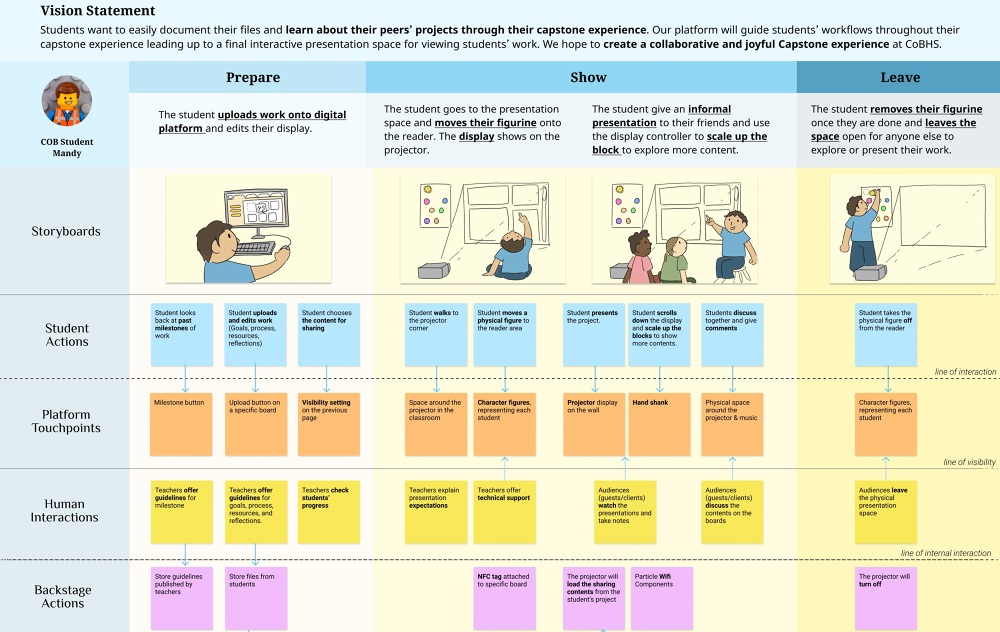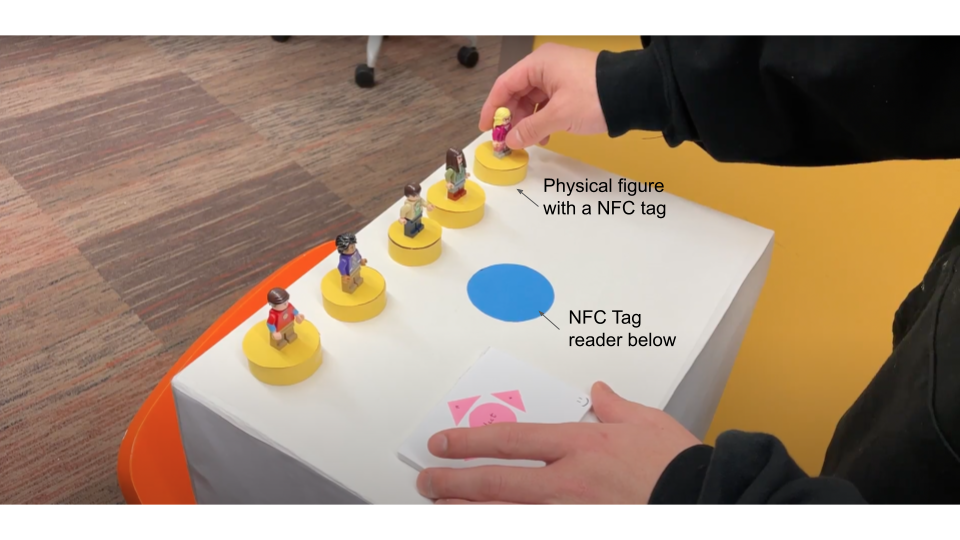PLAYWORKS
City of Bridges High School (CoB) uses a competency-based learning approach by assessing students' skills based on proficiency. Students demonstrate their accumulated skills, interests and competencies through a capstone project, a crucial final step before students graduate.
I led design research to establish the right direction for the final solution, and created a tool and experience to complement both students' work and City of Bridges' values.
This project was made possible through the efforts of:
︎︎︎ myself (product lead)
︎︎︎ Mandy Lin (UX research)
︎︎︎ Jenny Zhang (designer)
︎︎︎ Sewon Park (UX research)

A LITTLE BACKGROUND
We utilized various research methods (semi-structured interviews, focus groups, cultural probes) to get an idea of the environment we were working in—most of the team weren’t familiar with non-traditional schooling and what was expected of students. We found a few things:
1. City of Bridges values a joyful learning experience.
From observations and contextual interviews, we learned that students have flexible topic choices for their capstone projects and are able to shape their own learning experiences throughout their time at the school.
2. Student work should translate into tangible outcomes.
It wasn't always clear how students should demonstrate competencies to college admission officers and potential employers without a traditional grading system.
3. Students cherish working independently, but they also value collaboration, communication, and feedback.
The individualized nature of students' work gives each student freedom to explore and tailor their project experience, but students saw value in peer critiques, discussions, and sharing resources, especially in the face of a daunting project.
It wasn't always clear how students should demonstrate competencies to college admission officers and potential employers without a traditional grading system.
3. Students cherish working independently, but they also value collaboration, communication, and feedback.
The individualized nature of students' work gives each student freedom to explore and tailor their project experience, but students saw value in peer critiques, discussions, and sharing resources, especially in the face of a daunting project.
PROBLEM: A DAUNTING TASK
Through more focused contextual inquiry and testing ideas with storyboards we learned that:
The capstone needs more structure and specific deliverables in earlier stages to ensure that the actual project experience goes smoothly.
Students mentioned that they felt stressed about organizing the project and tracking their progress: "It's stressful to think about the capstone project because it's so self-directed." Oftentimes they thought of ideas last minute or left everything to the end because they weren’t sure where to start.
On the other hand, teachers don't have a systematic way to keep track of each student's deliverables because projects varied so widely, which is not scalable for a larger student body in the future.
We visualized a student's journey through the capstone project to find out when students need outside support the most.
Students mentioned that they felt stressed about organizing the project and tracking their progress: "It's stressful to think about the capstone project because it's so self-directed." Oftentimes they thought of ideas last minute or left everything to the end because they weren’t sure where to start.
On the other hand, teachers don't have a systematic way to keep track of each student's deliverables because projects varied so widely, which is not scalable for a larger student body in the future.
We visualized a student's journey through the capstone project to find out when students need outside support the most.

Students want to have a systematic way to organize files and visualize their projects' progress.
CoB heavily depends on physical folders and worksheets, which students collected along with their own work and inspirations to reference back to. Students often ended up literally burdened with a collection of ideas, and yet still felt unprepared for the capstone project and presentation.
CoB heavily depends on physical folders and worksheets, which students collected along with their own work and inspirations to reference back to. Students often ended up literally burdened with a collection of ideas, and yet still felt unprepared for the capstone project and presentation.

Based off what we learned, I defined our design goals:
I had the team design within a service design framework to map out the full intended experience. This map included user actions, teacher's support actions, implementation requirements, and a way to present context to stakeholders.
- Digitize and organize students' work and project progress
- Create a delightful way to collaborate and present the capstone
I had the team design within a service design framework to map out the full intended experience. This map included user actions, teacher's support actions, implementation requirements, and a way to present context to stakeholders.


SOLUTION: PlayWorks
PlayWorks is an interactive presentation space that improves the collaborative experience of seniors' capstone projects at City of Bridges High School.
PlayWorks is a platform that:
- Allows students and teachers to share files in one place
- Encourages collaborative ways to document and present work.
PlayWorks consists of a digital platform for students to upload their inspirations, progress, and milestones all in one place. This platform is connected to a physical presentation space in the school, with a projector and interactable objects for students to easily present their work, view other students’ work, and give and receive feedback to create a collaborative and joyful environment for the capstone journey.
I defined the product experience and visual requirements, then handed off the prototype design. PlayWorks mirrors the manila folders that students carry around at City of Bridges to ease a traditional space into a digital one. The platform is designed to be flexible for students to show their work in any way they like, retaining the freedom that they are used to. It also provides teachers with a better way to keep track of their students' work, and to give them more opportunities to support students when needed.
We also envisioned a presentation space within the school that is connected to the platform through NFC-tagged figurines (like Nintendo amiibos). We imagine flexible use cases for this presentation space, from informal student-to-student presentations and feedback sessions to a new marketing opportunity: an open house of student work that prospective students can look through.



IMPACT AND FINAL THOUGHTS
+100% positive student/teacher feedback
+100% student excitement
+organization and efficiency for students and teachers
We held a Q&A session after our presentation and set up user interviews showing our final solution to gather feedback. We got great feedback and excitement from students, especially regarding the milestones and organizational strategy.
One important aspect of our solution was to match the joyful aspect of the school and the freedom students had in the capstone; so, we came up with an unconventional, fun solution based on existing toys and NFC technology. A drawback to something so unconventional however, was that students and teachers seemed confused about the physical concept paired with a whole new digital platform. If I could do it again, I would make time in the presentation to show a physical demo of the concept, rather than explaining through a series of photos.
We were given freedom to bring something totally new to the table, but upon reflection implementing a platform as suggested wasn’t realistic for a tiny school with limited resources. I instead suggested adapting the organizational structure of PlayWorks to an existing platform such as Google Drive, and mapping NFC tags to Google Drive links for easy presentation.